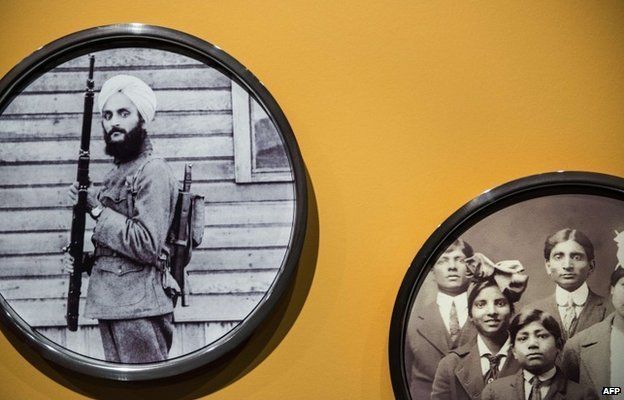Exploring how Indian Americans helped shape US
- Published

A new exhibition at the National Museum of Natural History in Washington celebrates Indian-American culture, history and experiences, as Diksha Basu reports.
When you enter Beyond Bollywood: Indian Americans Shape the Nation, you are greeted by loud Hindi film music and a vinyl record from Mughal-E-Azam, one of the most iconic Bollywood films.
But, as the title suggests, this exhibition is not just about Indian cinema.
'Diverse'
The curators from the Smithsonian Asian Pacific American Center say it about the "history and contemporary experiences of Indian Americans as they have grown to be one of the more diverse and well-recognised communities in the United States".
With a population of 2.8 million, Indian Americans are the third largest group among Asian Americans.
They are also among the wealthiest communities in the US, with a median annual household income of $88,000 (£52,900) compared with the national median of $49,800 (£29,900), according to one study.
And more than 70% of Indian American immigrants over 18 years of age speak English very well, compared with 53% of all Asian American immigrants.
The vast exhibition covers everything from Indian American food to yoga, engineers to cab drivers, and the LGBT community to hip hop.
With brightly coloured walls and background music, the exhibition is certainly pleasing to the senses.
Colourful Indian thalis, or steel plates, stuck on the wall provide statistical data on the community and are an attempt to tie the collection together.
The facts are interesting enough but they feel arbitrary and the entire exhibition, unfortunately, points more to what has been omitted than what has been included.
For instance, in an effort to be interactive, there is a podium where you can stand and be a contestant in a mock spelling bee because, we are informed, 73% of National Spelling Bee winners since 1999 have been Indian Americans.
Next to the podium is a life-size cut-out of Nina Davuluri, the Indian-American woman who was crowned Miss America 2014.
Both may represent key cultural contributions, but it is unclear why they are given such prominence.
There is also little room left for imperfections. Indian Americans are presented as a perfect, pleasing, model minority.
Not clear
The exhibition showcases aspects of Indian culture viewed through the lens of an earlier America.
Colourful Indian footwear is accompanied by a note informing you that Indians generally remove their shoes before entering their homes or any sacred places.
There is also a fully-set table with a vague description of Indian food and a box of spices, and a yoga room with a wall of mirrors in which you can strike yoga poses.
The show talks about the contribution of well-known Indian Americans, but it is not clear how these people have been selected.
A scattering of pictures and two mirrors on the wall encourage you to ask who Indian Americans are, but the answer remains unanswered in this exhibition. (One wall post does, however, clarify that, "Indian Americans are not American Indians.")
All the written posts refer to Indian Americans, meaning, presumably Indians resident in the US or Indians who hold American passports.
But there are no mentions or examples of the many Indian Americans who are becoming increasingly visible in US politics, journalism, academia, or business.
There is some awareness of activism and art in the show.
There are a few pictures of the Indian-American LGBT community, and a painting called DOTS by Anujun Ezhikode which was a response to the hate group, Dotbusters, that aimed to get Indians out of Jersey City in the 1980s.
Haunting
The most haunting part of the exhibition is the turban of Balbir Singh Sodhi, who was shot dead in Arizona by a man said to be seeking revenge on Muslims for 9/11.
Few other sections stand out.
Art director Chiraag Bhakta and photographer Mark Hewko have put together a section on Indian-American motel owners that is fascinating. Almost half the motels in the US are owned by Indians.
The uninspiring quotes by an "Indian American Child Who Grew Up In A Motel" do not add much, but the photographs of the motels are depressing and beautiful, and the section's faux-motel front is interestingly designed.
Photographer Dez Veeraswamy has contributed to some of the pictures on the walls, including a digital photo frame that has some wonderful pictures of Indians who settled in the Caribbean.
A 1952 picture of a Bengali-Puerto Rican family demonstrates the unusual history of some Indians in America.
Indian Americans are no longer a small, easily defined minority that can be captured and explained in a few brightly coloured rooms in a museum.
This exhibition is certainly aesthetically pleasing, but it barely scratches the surface of the growing Indian-American experience and its role in the US.
Diksha Basu is a writer and actor based in Mumbai and New York City
- Published10 February 2014
- Published29 December 2013
- Published26 June 2002